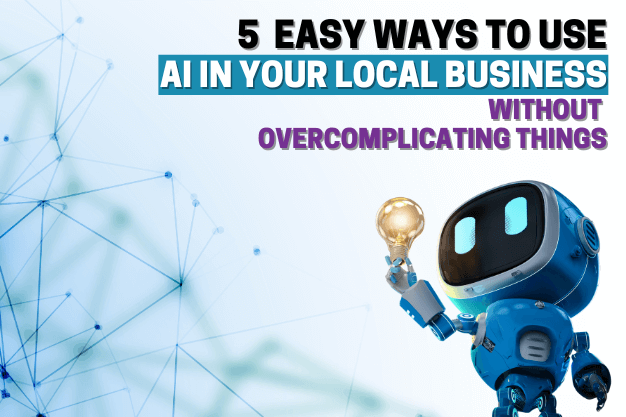AI—it sounds like something reserved for big tech companies and Silicon Valley, right? But here’s the truth: AI has never been more accessible for local business owners. And while you might hear about chatbots, automated emails, and “smart” analytics in the headlines, knowing exactly how to use these tools to grow your local business can seem overwhelming.
What if there were easy, actionable ways to integrate AI without needing a PhD in technology or a massive budget? The good news is, there are! Here are five simple ways to harness AI for your local business, to save time, improve customer experiences, and drive more sales.
1. AI-Enhanced Social Media Scheduling to Maximize Engagement:
Social media is a key driver for local businesses, but the pressure to post consistently can be overwhelming. Even if you already use a basic scheduling tool, there’s a difference between just posting and posting at the right time. AI can help you schedule content when your audience is most active and ready to engage.
How It Works: Advanced schedulers like Publer, Lately.ai, or Buffer do more than just auto-post. They analyze your audience engagement history and provide personalized recommendations on the best times to post based on real-time data. If you have a retail clothing store, for instance, you might learn that your audience is most engaged on Instagram around lunchtime and just before dinner. These tools let you schedule your posts ahead of time and then take it a step further by optimizing for the best time slots.
How to Implement It: Getting started is simple: sign up for one of these platforms, connect your social media accounts, and let the AI analyze your posting history. You can bulk-upload posts for a week or month at a time, and the AI will handle the rest—posting when it predicts your followers are most likely to see and engage with your content. A local bakery, for example, can use these platforms to post daily specials or behind-the-scenes content to keep customers coming back for fresh baked goods.
Pro Tip: Try A/B testing different types of content, such as videos, photos, and text posts, to see what works best. AI schedulers often provide engagement analytics to help refine your content strategy over time.
2. Chatbots: Your 24/7 Customer Service Assistant:
Imagine being able to assist every customer that visits your website, day or night, without needing someone to be “on call.” AI chatbots make this possible, and they’re far easier to set up than you might think. They allow you to answer common customer questions instantly, keep your audience engaged, and even drive sales.
How It Works: Tools like Tidio, ManyChat, and MobileMonkey provide simple chatbot templates designed for local businesses. These bots can answer frequently asked questions, schedule appointments, or even send out coupon codes—all in real-time.
How to Implement It: Using a drag-and-drop editor, you can set up a basic chatbot in under an hour. Think about the questions your customers commonly ask: “Are you open on Saturdays?” or “What are today’s specials?” A small restaurant could set up a bot that quickly provides its opening hours, menu, and directions, all while prompting visitors to book a reservation.
Pro Tip: Keep it simple. Don’t overcomplicate the bot with dozens of responses right away. Start with 3-5 common questions, test how customers interact, and expand based on feedback. This quick win can save you hours answering the same inquiries and boost customer satisfaction instantly.

3. Automated Review Requests to Build Trust and Credibility:
We all know how important online reviews are for attracting new customers and building trust, but asking for reviews can feel awkward and time-consuming. AI can take care of this for you, automatically and politely.
How It Works: Platforms like BirdEye and NiceJob are specifically designed to help local businesses gather more reviews. These tools work by sending automated follow-up messages to customers shortly after they purchase a product or receive a service, kindly asking them to share their feedback on Google, Facebook, or Yelp.
How to Implement It: You can connect these platforms to your existing CRM or point-of-sale system. Once a transaction is complete, the tool triggers an automatic message (usually via email or text) with a link to leave a review. For example, if you run a hair salon, the AI can send a quick text to a customer right after their appointment, saying, “We hope you loved your haircut! If you did, we’d appreciate your feedback!” The process is seamless, and by catching your customers while their experience is still fresh, you’re more likely to secure that positive review.
Pro Tip: Customize your messaging based on customer behavior. For repeat customers, thank them for their loyalty before asking for feedback. For first-timers, ask for feedback about their initial experience and how you can improve. Personalized messages tend to generate better responses.
4. AI-Driven Email Marketing That Practically Writes Itself:
Email marketing remains one of the most effective ways to connect with your audience, but sending the right message at the right time can be tricky. That’s where AI-powered email tools come in, helping you craft and send emails that are not only well-timed but also more relevant to each subscriber.
How It Works: Tools like Mailchimp and Sendinblue have AI features that use data analytics to decide the best times to send emails based on your subscribers’ behaviors. They can also help you craft content tailored to your audience’s interests by analyzing what kind of emails they open, click, or ignore.
How to Implement It: Instead of sending out blanket emails, segment your audience based on their past behavior (e.g., purchases, website visits, or past email interactions). Then use the AI’s recommendations to schedule the emails at times when your audience is most likely to open them. If you’re a home services business, like a lawn care company, AI can help you send seasonal reminders just as spring approaches or before winter hits, increasing the chances your email will drive bookings.
Pro Tip: Use AI to test subject lines and content. Many email platforms have built-in AI tools that help you A/B test different elements of your emails—like headlines, images, and calls to action—to see which versions generate more opens and clicks.

5. AI-Powered Design Tools for Professional Marketing Materials in Minutes:
Creating compelling visuals is crucial for local marketing, but not everyone has the budget to hire a graphic designer. Fortunately, AI-powered design tools make creating professional flyers, social media graphics, and even short promotional videos easy, even if you have no design skills whatsoever.
How It Works: Canva and InVideo are go-to tools that offer templates and AI design recommendations. Simply choose a template, drag and drop your logo, photos, or text, and the AI will make design suggestions to improve aesthetics and layout. These tools are designed to be beginner-friendly, so you don’t have to be a design expert to make your content look polished.
How to Implement It: Let’s say you own a pet grooming business. You want to create a set of social media posts to promote a special “Groom Your Pet for Less” event. Instead of spending hours trying to come up with a design, use Canva to find pre-made templates, add your details, and let the AI handle the alignment and color suggestions to keep everything visually appealing.
Pro Tip: Use design AI tools to create a set of branded templates you can reuse across different promotions. Once you have a consistent style, you’ll save time on future campaigns and ensure all your content looks professional and on-brand.
The Takeaway: Start Small and Scale as You Go:
AI might seem intimidating, but it’s actually a lot simpler than you think when you know where to start. The strategies mentioned here are designed to be quick wins—easy to implement and proven to boost your business.
Get started by choosing one or two tools to try this week. Whether it’s scheduling your social media posts more effectively, setting up an automated review request, or enhancing your email marketing, you’ll see how AI can make a difference with minimal effort.
Before you know it, these small adjustments will help your local business stay ahead of the competition, improve customer experiences, and save you time—so you can focus on what you do best.
Got questions or need help picking the right strategy for your business? Let’s connect and figure out how AI can simplify your marketing efforts. Until next time, keep up the good fight and embrace the power of easy AI!

